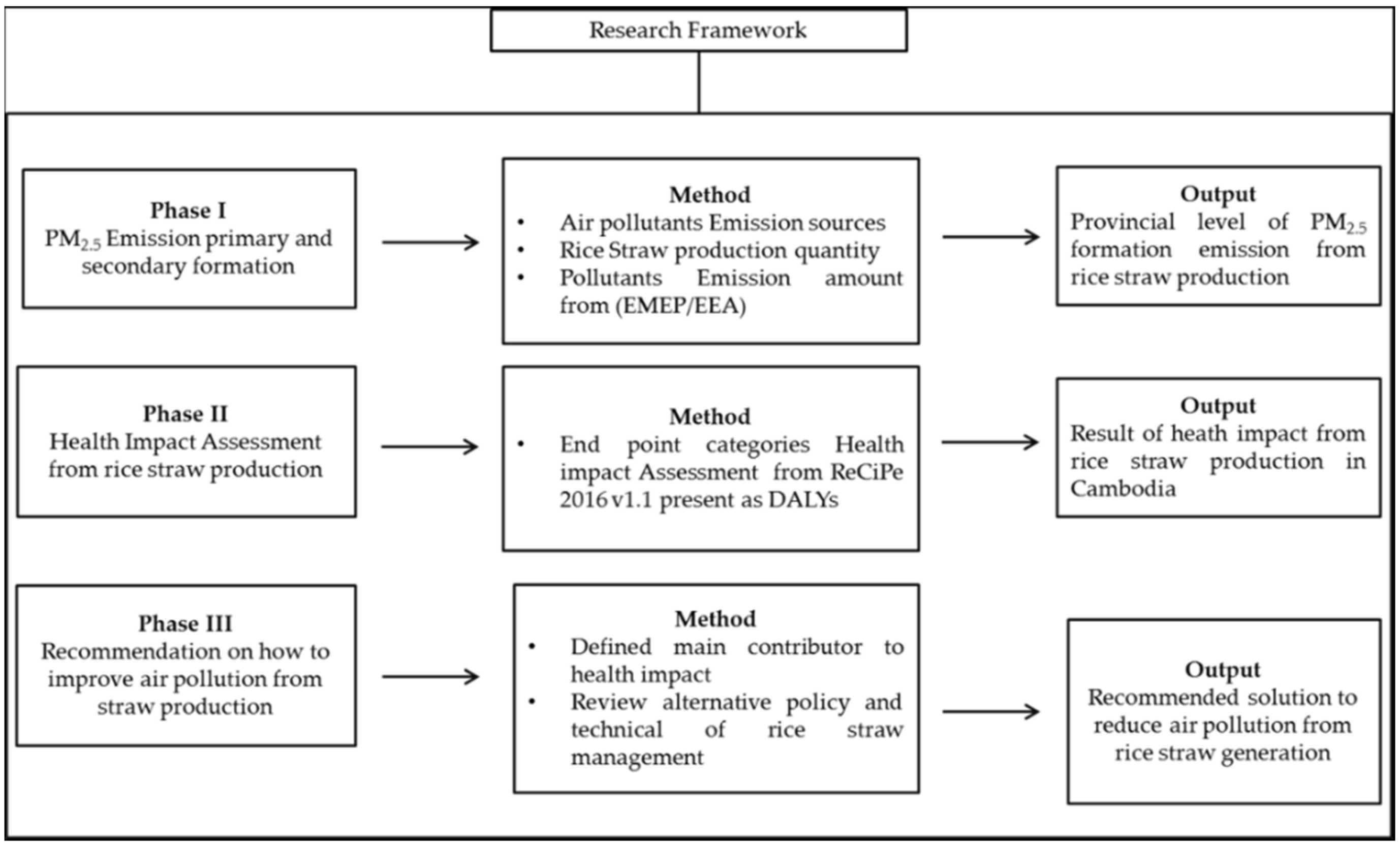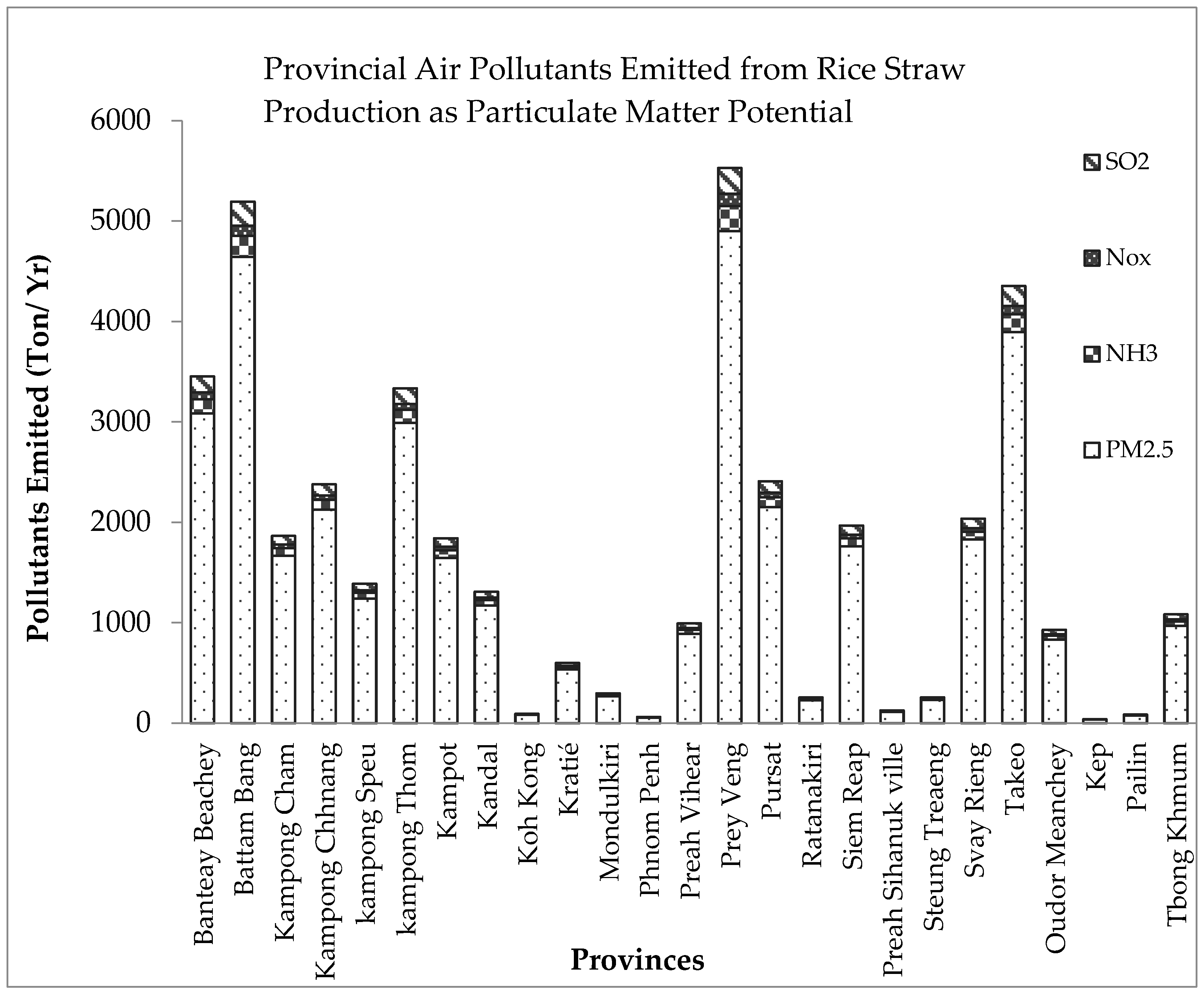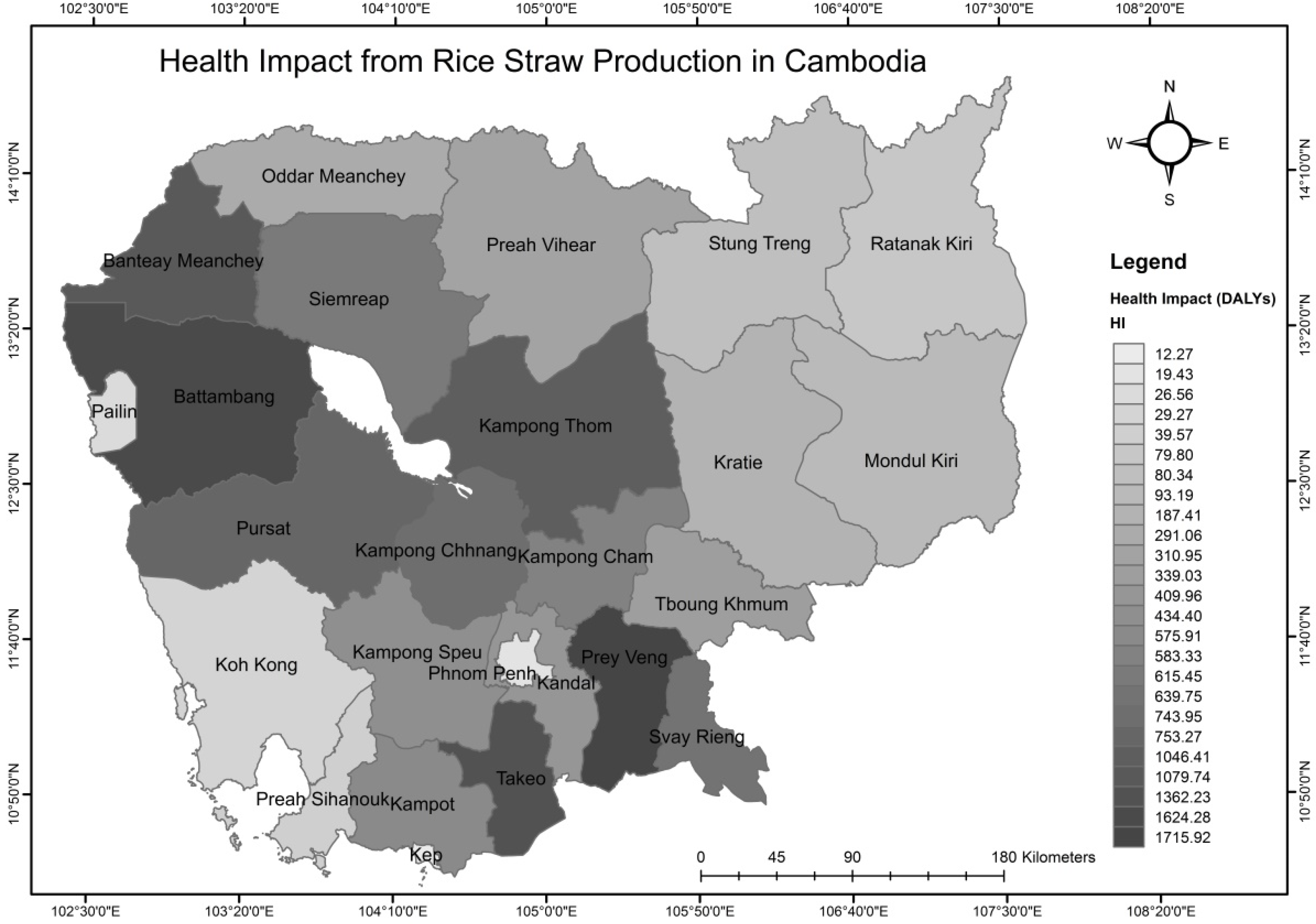Health Impact Assessment from Rice Straw Production in Cambodia
Abstract
1. Introduction
2. Materials and Methods
2.1. Study Area
2.2. Rice Straw Generation
2.3. Fertilizer Usage and Combustion in Rice Production
2.4. Emission Inventory
2.5. Human Health (DALYs)
3. Results and Discussion
3.1. Farmers Survey
3.2. Pollutants Emission Inventory
3.3. Health Impact (DALYs)
4. Conclusions
Author Contributions
Funding
Institutional Review Board Statement
Informed Consent Statement
Data Availability Statement
Acknowledgments
Conflicts of Interest
Appendix A
| Pollutants Emission Factor (kg/ton of Rice Paddy) | |||
|---|---|---|---|
| PM2.5 | NH3 | NOx | SO2 |
| 3.05 | 0.107 | 0.034 | 0.097 |
Appendix B
| Pollutants Emission Inventory (ton/year) | Health Impact (DALYs) | ||||||||
|---|---|---|---|---|---|---|---|---|---|
| Provinces | PM2.5 | NH3 | NOx | SO2 | PM2.5 | NH3 | NOx | SO2 | Total HI |
| Banteay Beachey | 5652.95 | 2819.39 | 792.77 | 408.76 | 1049.07 | 3.22 | 1.91 | 25.54 | 1079.74 |
| Battam Bang | 8503.84 | 4241.27 | 1192.58 | 614.90 | 1578.14 | 4.85 | 2.88 | 38.42 | 1624.28 |
| Kampong Cham | 3054.00 | 1523.17 | 428.29 | 220.83 | 566.76 | 1.74 | 1.03 | 13.80 | 583.33 |
| Kampong Chhnang | 3894.89 | 1942.57 | 546.22 | 281.64 | 722.81 | 2.22 | 1.32 | 17.60 | 743.95 |
| kampong Speu | 2274.29 | 1134.29 | 318.95 | 164.45 | 422.06 | 1.30 | 0.77 | 10.27 | 434.40 |
| kampong Thom | 5480.11 | 2726.05 | 763.21 | 396.26 | 1016.99 | 2.96 | 1.70 | 24.76 | 1046.41 |
| Kampot | 3015.16 | 1503.80 | 422.85 | 218.02 | 559.55 | 1.72 | 1.02 | 13.62 | 575.91 |
| Kandal | 2146.35 | 1070.49 | 301.00 | 155.20 | 398.32 | 1.22 | 0.73 | 9.70 | 409.96 |
| Koh Kong | 153.26 | 76.44 | 21.49 | 11.08 | 28.44 | 0.09 | 0.05 | 0.69 | 29.27 |
| Kratié | 981.17 | 489.36 | 137.60 | 70.95 | 182.09 | 0.56 | 0.33 | 4.43 | 187.41 |
| Mondulkiri | 487.87 | 243.32 | 68.42 | 35.28 | 90.54 | 0.28 | 0.17 | 2.20 | 93.19 |
| Phnom Penh | 101.74 | 50.74 | 14.27 | 7.36 | 18.88 | 0.06 | 0.03 | 0.46 | 19.43 |
| Preah Vihear | 1627.99 | 811.95 | 228.31 | 117.72 | 302.12 | 0.93 | 0.55 | 7.35 | 310.95 |
| Prey Veng | 8977.56 | 4503.05 | 1278.52 | 649.16 | 1666.05 | 5.71 | 3.60 | 40.56 | 1715.92 |
| Pursat | 3943.70 | 1966.91 | 553.06 | 285.17 | 731.87 | 2.25 | 1.33 | 17.82 | 753.27 |
| Ratanakiri | 417.81 | 208.38 | 58.59 | 30.21 | 77.54 | 0.24 | 0.14 | 1.89 | 79.80 |
| Siem Reap | 3222.18 | 1607.06 | 451.88 | 232.99 | 597.97 | 1.84 | 1.09 | 14.56 | 615.45 |
| Preah Sihanuk ville | 207.19 | 103.33 | 29.06 | 14.98 | 38.45 | 0.12 | 0.07 | 0.94 | 39.57 |
| Steung Treaeng | 420.60 | 209.77 | 58.98 | 30.41 | 78.05 | 0.24 | 0.14 | 1.90 | 80.34 |
| Svay Rieng | 3350.64 | 1665.97 | 465.87 | 242.28 | 621.81 | 1.79 | 1.02 | 15.14 | 639.75 |
| Takeo | 7131.86 | 3557.00 | 1000.17 | 515.70 | 1323.53 | 4.07 | 2.41 | 32.22 | 1362.23 |
| Oudor Meanchey | 1523.81 | 760.00 | 213.70 | 110.19 | 282.79 | 0.87 | 0.52 | 6.88 | 291.06 |
| Kep | 64.26 | 32.05 | 9.01 | 4.65 | 11.92 | 0.04 | 0.02 | 0.29 | 12.27 |
| Pailin | 139.05 | 69.35 | 19.50 | 10.05 | 25.81 | 0.08 | 0.05 | 0.63 | 26.56 |
| Tbong Khmum | 1774.96 | 885.26 | 248.92 | 128.35 | 329.40 | 1.01 | 0.60 | 8.02 | 339.03 |
| Total | 68,547.23 | 34,200.98 | 9623.23 | 4956.59 | 12,720.94 | 39.40 | 23.49 | 309.67 | 13,093.50 |
References
- Heylen, C.; Meunier, F.; Peeters, A.; Ek, S.; Neang, M.; Hean, S.; Peanh, S. Multidimensional Benefits of Sustainable Agriculture Practices of Cambodian Smallholder Farmers. Sustain. Agric. Res. 2020, 9, 10–25. [Google Scholar] [CrossRef]
- National-Institute-of-Statistics. Statistical Yearbook of Cambodia 2021. 2021. Available online: https://nis.gov.kh/nis/yearbooks/StatisticalYearbookofCambodia2021.pdf (accessed on 10 May 2022).
- Mundi, I. Cambodia Milled Rice Domestic Consumption by Year. 2022. Available online: https://www.indexmundi.com/agriculture/?country=kh&commodity=milled-rice&graph=domestic-consumption (accessed on 30 August 2022).
- MAFF. 2021 Annual Report of Ministry of Ministry of Agriculture, Forestry and Fisheries. 2021. Available online: https://elibrary.maff.gov.kh/book/623933d233e7d (accessed on 15 May 2022).
- Yu, B.; Diao, X. Cambodia’s agricultural strategy: Future development options for the rice sector. Cambodia Dev Resour Inst (CDRI), Counc Agric Rural Dev (CARD). IFPRI Spec. Rep. Phnom. Penh. 2011, 1284, 1282. [Google Scholar]
- ASEAN Secretariat. ASEAN Economic Community Blueprint; Association of Southeast Asian Nations: Jakarta, Indonesia, 2008. [Google Scholar]
- Secretariat, A. Roadmap on ASEAN Cooperation towards Transboundary Haze Pollution Control with Means of Implementation; Singapore Centre for International Law, National University: Singapore, 2016. [Google Scholar]
- Lin, C.-Y.; Hsu, H.-M.; Lee, Y.H.; Kuo, C.H.; Sheng, Y.-F.; Chu, D.A. A new transport mechanism of biomass burning from Indochina as identified by modeling studies. Atmos. Chem. Phys. 2009, 9, 7901–7911. [Google Scholar] [CrossRef]
- Oanh, N.T.K.; Permadi, D.A.; Hopke, P.K.; Smith, K.R.; Dong, N.P.; Dang, A.N. Annual emissions of air toxics emitted from crop residue open burning in Southeast Asia over the period of 2010–2015. Atmos. Environ. 2018, 187, 163–173. [Google Scholar] [CrossRef]
- Oanh, N.T.K.; Ly, B.T.; Tipayarom, D.; Manandhar, B.R.; Prapat, P.; Simpson, C.D.; Liu, L.-J.S. Characterization of particulate matter emission from open burning of rice straw. Atmos. Environ. 2011, 45, 493–502. [Google Scholar] [CrossRef] [PubMed]
- Yadav, I.C.; Devi, N.L. Biomass burning, regional air quality, and climate change. Earth Syst. Environ. Sci. Ed. Encycl. Environ. Health 2018, 227, 414–427. [Google Scholar]
- Andreae, M.O.; Merlet, P. Emission of trace gases and aerosols from biomass burning. Glob. Biogeochem. Cycles 2001, 15, 955–966. [Google Scholar] [CrossRef]
- Tipayarom, D.; Oanh, N.T.K. Effects from open rice straw burning emission on air quality in the Bangkok Metropolitan Region. Sci. Asia 2007, 33, 339–345. [Google Scholar] [CrossRef]
- Aneja, V.P. Proceedings, Workshop on Agricultural Air Quality: State of the Science; Dept. of Communication Services, North Carolina State University: Raleigh, NC, USA, 2006. [Google Scholar]
- Yin, S.; Wang, X.; Zhang, X.; Guo, M.; Miura, M.; Xiao, Y. Influence of biomass burning on local air pollution in mainland Southeast Asia from 2001 to 2016. Environ. Pollut. 2019, 254, 112949. [Google Scholar] [CrossRef] [PubMed]
- Apte, J.S.; Marshall, J.D.; Cohen, A.J.; Brauer, M. Addressing global mortality from ambient PM2.5. Environ. Sci. Technol. 2015, 49, 8057–8066. [Google Scholar] [CrossRef] [PubMed]
- Ritchie, H.; Roser, M. Indoor Air Pollution. Our World Data. 2013. Available online: https://ourworldindata.org/indoor-air-pollution (accessed on 27 July 2022).
- WHO. Deaths Linked to Outdoor and Household Air Pollution. 2021. Available online: https://www.who.int/mongolia/multi-media/item/deaths-linked-to-outdoor-and-household-air-pollution (accessed on 27 July 2022).
- Kosal, N. Rice Straw Management in Cambodia. Department of Agricultural Engineering, Ministry of Agriculture, Forestry and Fisheries. Phnom Penh. 2019. Available online: http://un-csam.org/sites/default/files/2020-11/RiceStrawManagementinCambodia_Mr.NginKosal.pdf (accessed on 20 August 2022).
- Kim Oanh, N.T.; Thuy, L.B.; Tipayarom, D.; Manadhar, B.R.; Pongkiatkul, P.; Simpson, C.D.; Sally, L.J.L. Source characterization of aerosol emission from field burning of rice straw. Atmos. Env. 2010, 45, 493–502. [Google Scholar] [CrossRef] [PubMed]
- Deuja, A.; Ueda, K.; Panyametheekul, S.; Gheewala, S.H.; Prapaspongsa, T. Health Impacts and Cost Assessment of Fine Particulate Matter Formation from Rice Straw Utilization in Thailand. Thai Environ. Eng. J. 2022, 36, 33–47. [Google Scholar]
- ISO 14040:2006; Environmental Management Life Cycle Assessment—Principles and Framework. ISO: London, UK, 2006.
- Shrestha, R.M.; Kim Oanh, N.T.; Shrestha, R.P.; Rupakheti, M.; Rajbhandari, S.; Permadi, D.A.; Kanabkaew, T.; Iyngararasan, M. Atmospheric Brown Clouds: Emission Inventory Manual; United Nations Environment Programme: Nairobi, Kenya, 2013. [Google Scholar]
- Gadde, B.; Menke, C.; Wassmann, R. Possible energy utilization of rice straw in Thailand: Seasonal and spatial variations in straw availability as well as potential reduction in greenhouse gas emissions. In Proceedings of the GMSARN International Conference on Sustainable Development: Challenges and Opportunities for GMS, GMSARN Secretariat, AIT, Pattaya, Thailand, 12–14 December 2007. [Google Scholar]
- Koopmans, A.; Koppejan, J. Agricultural and forest residues-generation, utilization and availability. Reg. Consult Mod. Appl. Biomass. Energy 1997, 6, 10. [Google Scholar]
- Streets, D.G.; Zhang, Q.; Wang, L.; He, K.; Hao, J.; Wu, Y.; Tang, Y.; Carmichael, G.R. Revisiting China’s CO emissions after the Transport and Chemical Evolution over the Pacific (TRACE-P) mission: Synthesis of inventories, atmospheric modeling, and observations. J. Geophys. Res. Atmos. 2006, 111. [Google Scholar] [CrossRef]
- Nanjundeswaraswamy, T.S.; Divakar, S. Determination of sample size and sampling methods in applied research. Proc. Eng. Sci. 2021, 3, 25–32. [Google Scholar] [CrossRef]
- EMEP/EEA Air Pollutant Emission Inventory Guidebook 2019. EMEP/EEA. 2019. 38p. Available online: http://www.envihaifa.org.il/prdFiles/1.A.4Smallcombustion2019.pdf (accessed on 20 April 2022).
- Oanh, N.T.K.; Tipayarom, A.; Bich, T.L.; Tipayarom, D.; Simpson, C.D.; Hardie, D.; Liu, L.-J.S. Characterization of gaseous and semi-volatile organic compounds emitted from field burning of rice straw. Atmos. Environ. 2015, 119, 182–191. [Google Scholar] [CrossRef]
- Kanabkaew, T.; Oanh, N.T.K. Development of Spatial and Temporal Emission Inventory for Crop Residue Field Burning. Environ. Model. Assess. 2010, 16, 453–464. [Google Scholar] [CrossRef]
- Huijbregts, M.A.J.; Steinmann, Z.J.N.; Elshout, P.M.F.; Stam, G.; Verones, F.; Vieira, M.; Zijp, M.; Hollander, A.; van Zelm, R. ReCiPe2016: A harmonised life cycle impact assessment method at midpoint and endpoint level. Int. J. Life Cycle Assess. 2017, 22, 138–147. [Google Scholar] [CrossRef]
- WHO. The Global Health Observatory. Available online: https://www.who.int/data/gho/indicator-metadata-registry/imr-details/158 (accessed on 7 May 2022).
- Ren, J.; Yu, P.; Xu, X. Straw Utilization in China—Status and Recommendations. Sustainability 2019, 11, 1762. [Google Scholar] [CrossRef]
- Kumar, K.; Goh, K.M.; Scott, W.R.; Frampton, C.M. Effects of 15N-labelled crop residues and management practices on subsequent winter wheat yields, nitrogen benefits and recovery under field conditions. J. Agric. Sci. 2001, 136, 35–53. [Google Scholar] [CrossRef]
- Kongnov, T. Ministry of Environment Issues Ban on Burning Rice Straw to Avoid Air Pollution. Khmer Tiimes. Available online: https://www.khmertimeskh.com/50792714/ministry-of-environment-issues-ban-on-burning-rice-straw-to-avoid-air-pollution (accessed on 4 December 2020).




| Emitted Substance | Emission Factor of Pollutants g/kg of Dry Straw | Particulate Matter Formation Potential (PMFP) kg Primary PM2.5 eq/kg |
|---|---|---|
| PM2.5 | 8.3 | 0.54 |
| NH3 | 4.1 | 0.04 |
| NOx | 1.12 | 0.05 |
| SO2 | 0.51 | 0.28 |
| Data Type | Data Used | Data Source |
|---|---|---|
| Primary Data | Whole process of Short-term rice production | Interview and Questionnaires (QN) |
| Fertilizer usage for rice production | Interview and QN | |
| Diesel and Gasoline use for rice production | Interview and QN | |
| Farmers practice of rice straw Management | Interview and QN | |
| Secondary Data | Pollutants Emission Inventory | EMEP/EEA-guidebook-2019 |
| Cambodia rice production 2021 | Ministry of Agriculture, Forestry, and Fisheries |
| Pollutants Emission Factor (kg/ton Rice) | |||||
|---|---|---|---|---|---|
| Pollutants | Prey Veng | Svay Rieng | Kampong Thom | Average | Emission Activities |
| PM2.5 | 0.021 | 0.021 | 0.021 | 0.02 | Combustion |
| NH3 | 1.25 | 0.62 | 0.65 | 0.84 | Fertilizer |
| NOx | 0.96 | 0.54 | 0.57 | 0.69 | Fertilizer & Combustion |
| SO2 | 0.22 | 0.22 | 0.22 | 0.22 | Combustion |
Publisher’s Note: MDPI stays neutral with regard to jurisdictional claims in published maps and institutional affiliations. |
© 2022 by the authors. Licensee MDPI, Basel, Switzerland. This article is an open access article distributed under the terms and conditions of the Creative Commons Attribution (CC BY) license (https://creativecommons.org/licenses/by/4.0/).
Share and Cite
Lorn, S.; Ket, P.; Or, C.; Kong, S.; Um, D.; Aun, S.; Taing, C.; Hang, L. Health Impact Assessment from Rice Straw Production in Cambodia. Appl. Sci. 2022, 12, 10276. https://doi.org/10.3390/app122010276
Lorn S, Ket P, Or C, Kong S, Um D, Aun S, Taing C, Hang L. Health Impact Assessment from Rice Straw Production in Cambodia. Applied Sciences. 2022; 12(20):10276. https://doi.org/10.3390/app122010276
Chicago/Turabian StyleLorn, Sokles, Pinnara Ket, Chanmoly Or, Sela Kong, Dalin Um, Srean Aun, Chanreaksmey Taing, and Leakhena Hang. 2022. "Health Impact Assessment from Rice Straw Production in Cambodia" Applied Sciences 12, no. 20: 10276. https://doi.org/10.3390/app122010276
APA StyleLorn, S., Ket, P., Or, C., Kong, S., Um, D., Aun, S., Taing, C., & Hang, L. (2022). Health Impact Assessment from Rice Straw Production in Cambodia. Applied Sciences, 12(20), 10276. https://doi.org/10.3390/app122010276






